Gabrielle Bonheur “Coco” Chanel (19 August 1883 – 10 January 1971)
“Fashion is not something that exists in dresses only. Fashion is in the sky, in the street, fashion has to do with ideas, the way we live, what is happening.”
– Coco Chanel
Coco Chanel was a leading French modernist designer, whose patterns of simplicity and style revolutionised women’s clothing. She was the only designer to be listed in the Time 100 most influential people of the Twentieth Century.
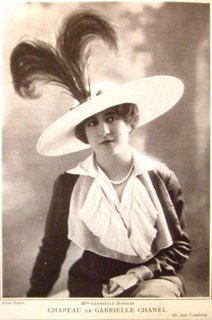 During the 1920s, in particular, Coco Chanel left a lasting mark on women’s fashion and design. Up until the First World War, women’s clothing had been quite restrictive and tended to involve full-length skirts which were impractical for many activities. Coco Chanel helped create women’s clothing that was simpler and more practical. She also introduced trousers and suits for women – something which had not been done before.
During the 1920s, in particular, Coco Chanel left a lasting mark on women’s fashion and design. Up until the First World War, women’s clothing had been quite restrictive and tended to involve full-length skirts which were impractical for many activities. Coco Chanel helped create women’s clothing that was simpler and more practical. She also introduced trousers and suits for women – something which had not been done before.
“Fashion has become a joke. The designers have forgotten that there are women inside the dresses. Most women dress for men and want to be admired. But they must also be able to move, to get into a car without bursting their seams! Clothes must have a natural shape.”
– Coco Chanel
She also created her famous Chanel No.5 scent, and this has become a lasting trademark.
Early life of Coco Chanel
Most sources suggest Gabrielle Chanel was born in 1883, though this was a closely guarded fact – with Coco not keen on revealing her birth date. Her mother was unmarried and her upbringing was marked by poverty and uncertainty. Aged 12, her mother died, and her father sent his three daughters including Gabrielle to a convent in Correze. Life in the religious institution was strict and frugal, but she did learn to sew and gain a rudimentary knowledge of creating clothes.
At the age of 18, she left the convent and moved to Moulins. She gained work as a seamstress and pursued a secondary career singing at cabaret events, however, her singing was not good enough to enable a stage career. Around 1908, Chanel began an affair with Étienne Balsan, a rich aristocrat. This enabled Chanel to become acquainted with many wealthy aristocrats and a different social circle.
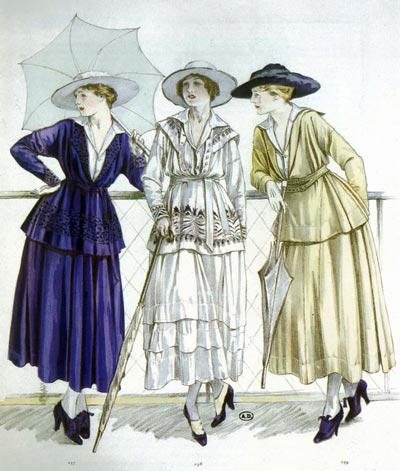
Early Chanel Casual wear – 1917
In 1913, with financial aid from a lover Arthur Capel, Chanel opened a boutique selling fashionable clothes in Deauville. She made innovative use of jersey fabric – a manufactured cloth which proved useful during the shortages of the First World War. She quickly gained a rising reputation for being on the forefront of fashion, and her initial success encouraged her to start another shop in Biarritz which prospered as a venue for the wealthy during the First World War.
By 1919, Chanel was able to open her first boutique in Paris on 31 rue Cambon, at the heart of the most fashionable area of Paris.
“In 1919 I woke up famous. I’d never guessed it. If I’d known I was famous, I’d have stolen away and wept. I was stupid. I was supposed to be intelligent. I was sensitive and very dumb.”
– Coco Chanel: Her Life, Her Secrets (1971), p. 95
In the post-war period, she felt the need for a revolution in women’s clothes. She began by liberating women from the bondage of the corset and encouraged a casual but elegant range of clothes.
“With a black sweater and 10 rows of pearls Chanel revolutionized fashion”
– Dior on Coco Chanel.
The 1920s were a significant period of liberation for women. It was a decade where women received the vote in several western countries. It was also a time when women were increasingly seen in professions and jobs, previously the reserve of men. Her fashion symbolised some of these social and political changes.
Significant items of clothing Coco Chanel helped pioneer included:
- the collarless cardigan jacket
- the bias cut dress – labelled a Ford by one critic because everyone had one.
- The shoe string shoulder strap.
- The floating evening scarf
- The wearing together of junk and real jewels.
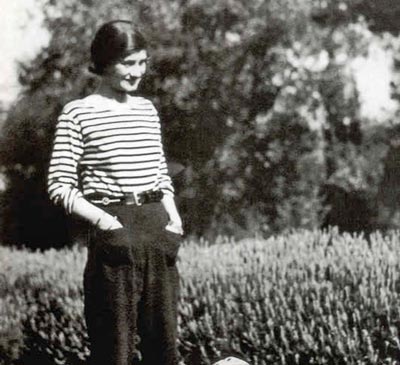
Chanel in sailors outfit 1928
In 1938, she retired from the fashion business. However, 16 years later, she made a determined comeback after becoming fed up with seeing French fashion become dominated by men.
Her first post-war collection was not well received by the critics, but it proved immensely popular with the general public. Rich and famous women once again adopted the Chanel look, and she had shown her lasting influence on the industry.
“In order to be irreplaceable one must always be different.”
– Coco Chanel
She prided herself on her great taste, fashion and practicality combined with an awareness of what people wanted. It was this that made her the most recognisable name in world fashion.
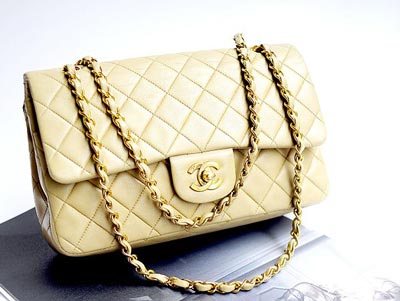
Chanel 2.55
Chanel was an innovator in many aspects of fashion. She developed a new kind of jewellery which imitated much more expensive jewellery. It enabled wealthy people to keep their expensive jewellery at home.
In 1929, she developed the iconic Chanel bag. Like other Chanel creations, it combined beauty, fashion and practicality. The thin strap – enabling hands to be kept free. In 1948, she updated the design to become the Chanel 2.55
Coco Chanel during World War Two
At the start of the Second World War in 1939, Chanel closed her shops stating that war was not a time for fashion. 3,000 of her workers lost their jobs – it was seen partly as retaliation for previous conflicts with workers, where her workers had sought better wages and conditions.
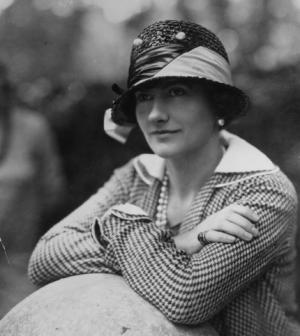 During the German occupation of Paris, Chanel was involved in a romantic liaison with a German officer, Hans Gunther von Dincklage. This helped her to gain a luxury apartment in the Ritz for the duration of the war. Combined with her political beliefs which expressed anti-Semitism and sympathy for various aspects of the German cause, Chanel’s wartime record has been placed under much scrutiny. Biographer Hal Vaughan discovered declassified documents which suggest Chanel worked for General Walter Schellenberg, chief of SS intelligence. At the end of the war, Schellenberg was convicted of war crimes and sentenced to six years. On his release, Chanel paid for his medical treatment.
Other declassified information shows that in 1943/44 Chanel was to be used as a courier for the SS to pursue a separate peace deal with Churchill and the Allies. The plan never succeeded.
In September 1944, Chanel was interrogated by the Free French Purge Committee, the épuration. She was released due to lack of evidence. Some sources suggest that Winston Churchill directly intervened to make sure Chanel was released – Churchill was possibly worried that if sent to trial, Chanel would embarrass the government with her links to top ranking Nazi’s and sympathisers in the British establishment.
In the climate of post-war interrogations, Chanel moved to Switzerland where she resided until 1954. The post-war period saw the emergence of new male designers, such as Christian Dior, who began to eclipse Chanel’s branding. However, in 1954, she returned to Paris and reopened her couture house. Her post-war label was successful in America and Britain, but less so in France. Many Frenchmen continued to hold her war record against her.
Chanel never married or had children. During her life, she had numerous relationships with influential men. This included poet Pierre Reverdy and the designer Paul Iribe.
Many biographers have said that Coco Chanel remains an enigma – a life full of contradiction and hard to ascertain her real motives.
During the German occupation of Paris, Chanel was involved in a romantic liaison with a German officer, Hans Gunther von Dincklage. This helped her to gain a luxury apartment in the Ritz for the duration of the war. Combined with her political beliefs which expressed anti-Semitism and sympathy for various aspects of the German cause, Chanel’s wartime record has been placed under much scrutiny. Biographer Hal Vaughan discovered declassified documents which suggest Chanel worked for General Walter Schellenberg, chief of SS intelligence. At the end of the war, Schellenberg was convicted of war crimes and sentenced to six years. On his release, Chanel paid for his medical treatment.
Other declassified information shows that in 1943/44 Chanel was to be used as a courier for the SS to pursue a separate peace deal with Churchill and the Allies. The plan never succeeded.
In September 1944, Chanel was interrogated by the Free French Purge Committee, the épuration. She was released due to lack of evidence. Some sources suggest that Winston Churchill directly intervened to make sure Chanel was released – Churchill was possibly worried that if sent to trial, Chanel would embarrass the government with her links to top ranking Nazi’s and sympathisers in the British establishment.
In the climate of post-war interrogations, Chanel moved to Switzerland where she resided until 1954. The post-war period saw the emergence of new male designers, such as Christian Dior, who began to eclipse Chanel’s branding. However, in 1954, she returned to Paris and reopened her couture house. Her post-war label was successful in America and Britain, but less so in France. Many Frenchmen continued to hold her war record against her.
Chanel never married or had children. During her life, she had numerous relationships with influential men. This included poet Pierre Reverdy and the designer Paul Iribe.
Many biographers have said that Coco Chanel remains an enigma – a life full of contradiction and hard to ascertain her real motives.
“Despite the work of a dozen biographers … Chanel remains an enigma.”
David Downie, in Paris, Paris: Journey Into the City of Light (2005)
She died on 10 January 1971, aged 87 at the Hotel Ritz, where she had resided for more than 30 years.
In the 1960s, a Broadway musical was made about her life starring Katharine Hepburn.
Gabrielle Bonheur “Coco” Chanel (19 August 1883 – 10 January 1971)
“Fashion is not something that exists in dresses only. Fashion is in the sky, in the street, fashion has to do with ideas, the way we live, what is happening.”
– Coco Chanel
Coco Chanel was a leading French modernist designer, whose patterns of simplicity and style revolutionised women’s clothing. She was the only designer to be listed in the Time 100 most influential people of the Twentieth Century.
 During the 1920s, in particular, Coco Chanel left a lasting mark on women’s fashion and design. Up until the First World War, women’s clothing had been quite restrictive and tended to involve full-length skirts which were impractical for many activities. Coco Chanel helped create women’s clothing that was simpler and more practical. She also introduced trousers and suits for women – something which had not been done before.
During the 1920s, in particular, Coco Chanel left a lasting mark on women’s fashion and design. Up until the First World War, women’s clothing had been quite restrictive and tended to involve full-length skirts which were impractical for many activities. Coco Chanel helped create women’s clothing that was simpler and more practical. She also introduced trousers and suits for women – something which had not been done before.“Fashion has become a joke. The designers have forgotten that there are women inside the dresses. Most women dress for men and want to be admired. But they must also be able to move, to get into a car without bursting their seams! Clothes must have a natural shape.”
– Coco Chanel
She also created her famous Chanel No.5 scent, and this has become a lasting trademark.
Early life of Coco Chanel
Most sources suggest Gabrielle Chanel was born in 1883, though this was a closely guarded fact – with Coco not keen on revealing her birth date. Her mother was unmarried and her upbringing was marked by poverty and uncertainty. Aged 12, her mother died, and her father sent his three daughters including Gabrielle to a convent in Correze. Life in the religious institution was strict and frugal, but she did learn to sew and gain a rudimentary knowledge of creating clothes.
At the age of 18, she left the convent and moved to Moulins. She gained work as a seamstress and pursued a secondary career singing at cabaret events, however, her singing was not good enough to enable a stage career. Around 1908, Chanel began an affair with Étienne Balsan, a rich aristocrat. This enabled Chanel to become acquainted with many wealthy aristocrats and a different social circle.

Early Chanel Casual wear – 1917
In 1913, with financial aid from a lover Arthur Capel, Chanel opened a boutique selling fashionable clothes in Deauville. She made innovative use of jersey fabric – a manufactured cloth which proved useful during the shortages of the First World War. She quickly gained a rising reputation for being on the forefront of fashion, and her initial success encouraged her to start another shop in Biarritz which prospered as a venue for the wealthy during the First World War.
By 1919, Chanel was able to open her first boutique in Paris on 31 rue Cambon, at the heart of the most fashionable area of Paris.
“In 1919 I woke up famous. I’d never guessed it. If I’d known I was famous, I’d have stolen away and wept. I was stupid. I was supposed to be intelligent. I was sensitive and very dumb.”
– Coco Chanel: Her Life, Her Secrets (1971), p. 95
In the post-war period, she felt the need for a revolution in women’s clothes. She began by liberating women from the bondage of the corset and encouraged a casual but elegant range of clothes.
“With a black sweater and 10 rows of pearls Chanel revolutionized fashion”
– Dior on Coco Chanel.
The 1920s were a significant period of liberation for women. It was a decade where women received the vote in several western countries. It was also a time when women were increasingly seen in professions and jobs, previously the reserve of men. Her fashion symbolised some of these social and political changes.
Significant items of clothing Coco Chanel helped pioneer included:
- the collarless cardigan jacket
- the bias cut dress – labelled a Ford by one critic because everyone had one.
- The shoe string shoulder strap.
- The floating evening scarf
- The wearing together of junk and real jewels.

Chanel in sailors outfit 1928
In 1938, she retired from the fashion business. However, 16 years later, she made a determined comeback after becoming fed up with seeing French fashion become dominated by men.
Her first post-war collection was not well received by the critics, but it proved immensely popular with the general public. Rich and famous women once again adopted the Chanel look, and she had shown her lasting influence on the industry.
“In order to be irreplaceable one must always be different.”
– Coco Chanel
She prided herself on her great taste, fashion and practicality combined with an awareness of what people wanted. It was this that made her the most recognisable name in world fashion.

Chanel 2.55
Chanel was an innovator in many aspects of fashion. She developed a new kind of jewellery which imitated much more expensive jewellery. It enabled wealthy people to keep their expensive jewellery at home.
In 1929, she developed the iconic Chanel bag. Like other Chanel creations, it combined beauty, fashion and practicality. The thin strap – enabling hands to be kept free. In 1948, she updated the design to become the Chanel 2.55
Coco Chanel during World War Two
At the start of the Second World War in 1939, Chanel closed her shops stating that war was not a time for fashion. 3,000 of her workers lost their jobs – it was seen partly as retaliation for previous conflicts with workers, where her workers had sought better wages and conditions.
 During the German occupation of Paris, Chanel was involved in a romantic liaison with a German officer, Hans Gunther von Dincklage. This helped her to gain a luxury apartment in the Ritz for the duration of the war. Combined with her political beliefs which expressed anti-Semitism and sympathy for various aspects of the German cause, Chanel’s wartime record has been placed under much scrutiny. Biographer Hal Vaughan discovered declassified documents which suggest Chanel worked for General Walter Schellenberg, chief of SS intelligence. At the end of the war, Schellenberg was convicted of war crimes and sentenced to six years. On his release, Chanel paid for his medical treatment.
During the German occupation of Paris, Chanel was involved in a romantic liaison with a German officer, Hans Gunther von Dincklage. This helped her to gain a luxury apartment in the Ritz for the duration of the war. Combined with her political beliefs which expressed anti-Semitism and sympathy for various aspects of the German cause, Chanel’s wartime record has been placed under much scrutiny. Biographer Hal Vaughan discovered declassified documents which suggest Chanel worked for General Walter Schellenberg, chief of SS intelligence. At the end of the war, Schellenberg was convicted of war crimes and sentenced to six years. On his release, Chanel paid for his medical treatment.
Other declassified information shows that in 1943/44 Chanel was to be used as a courier for the SS to pursue a separate peace deal with Churchill and the Allies. The plan never succeeded.
In September 1944, Chanel was interrogated by the Free French Purge Committee, the épuration. She was released due to lack of evidence. Some sources suggest that Winston Churchill directly intervened to make sure Chanel was released – Churchill was possibly worried that if sent to trial, Chanel would embarrass the government with her links to top ranking Nazi’s and sympathisers in the British establishment.
In the climate of post-war interrogations, Chanel moved to Switzerland where she resided until 1954. The post-war period saw the emergence of new male designers, such as Christian Dior, who began to eclipse Chanel’s branding. However, in 1954, she returned to Paris and reopened her couture house. Her post-war label was successful in America and Britain, but less so in France. Many Frenchmen continued to hold her war record against her.
Chanel never married or had children. During her life, she had numerous relationships with influential men. This included poet Pierre Reverdy and the designer Paul Iribe.
Many biographers have said that Coco Chanel remains an enigma – a life full of contradiction and hard to ascertain her real motives.
“Despite the work of a dozen biographers … Chanel remains an enigma.”
David Downie, in Paris, Paris: Journey Into the City of Light (2005)
She died on 10 January 1971, aged 87 at the Hotel Ritz, where she had resided for more than 30 years.
In the 1960s, a Broadway musical was made about her life starring Katharine Hepburn.



No comments:
Post a Comment